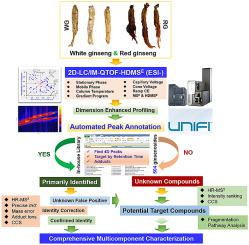Journal of Pharmaceutical Analysis ( IF 8.8 ) Pub Date : 2019-11-03 , DOI: 10.1016/j.jpha.2019.11.001 Tiantian Zuo , Chunxia Zhang , Weiwei Li , Hongda Wang , Ying Hu , Wenzhi Yang , Li Jia , Xiaoyan Wang , Xiumei Gao , Dean Guo

|
Inherent complexity of plant metabolites necessitates the use of multi-dimensional information to accomplish comprehensive profiling and confirmative identification. A dimension-enhanced strategy, by offline two-dimensional liquid chromatography/ion mobility-quadrupole time-of-flight mass spectrometry (2D-LC/IM-QTOF-MS) enabling four-dimensional separations (2D-LC, IM, and MS), is proposed. In combination with in-house database-driven automated peak annotation, this strategy was utilized to characterize ginsenosides simultaneously from white ginseng (WG) and red ginseng (RG). An offline 2D-LC system configuring an Xbridge Amide column and an HSS T3 column showed orthogonality 0.76 in the resolution of ginsenosides. Ginsenoside analysis was performed by data-independent high-definition MSE (HDMSE) in the negative ESI mode on a Vion™ IMS-QTOF hybrid high-resolution mass spectrometer, which could better resolve ginsenosides than MSE and directly give the CCS information. An in-house ginsenoside database recording 504 known ginsenosides and 58 reference compounds, was established to assist the identification of ginsenosides. Streamlined workflows, by applying UNIFI™ to automatedly annotate the HDMSE data, were proposed. We could separate and characterize 323 ginsenosides (including 286 from WG and 306 from RG), and 125 thereof may have not been isolated from the Panax genus. The established 2D-LC/IM-QTOF-HDMSE approach could also act as a magnifier to probe differentiated components between WG and RG. Compared with conventional approaches, this dimension-enhanced strategy could better resolve coeluting herbal components and more efficiently, more reliably identify the multicomponents, which, we believe, offers more possibilities for the systematic exposure and confirmative identification of plant metabolites.
中文翻译:

离线二维液相色谱与离子淌度-四极杆飞行时间质谱联用,可对白参和红参中的多组分进行四维分离和表征
植物代谢物固有的复杂性需要使用多维信息来完成全面的分析和确认性鉴定。通过离线二维液相色谱/离子淌度-四极杆飞行时间质谱(2D-LC / IM-QTOF-MS)进行维增强的策略,实现了维分离(2D-LC,IM和MS) ),建议。结合内部数据库驱动的自动峰注释,该策略可同时从白参(WG)和红参(RG)表征人参皂苷。配置Xbridge Amide色谱柱和HSS T3色谱柱的离线2D-LC系统在人参皂苷的分离度中显示正交度为0.76。人参皂苷分析是通过与数据无关的高清MS E(HDMS E)在Vion™IMS-QTOF混合高分辨率质谱仪上以负ESI模式运行,比MS E可以更好地解析人参皂苷并直接提供CCS信息。建立了一个内部人参皂甙数据库,该数据库记录了504种已知人参皂甙和58种参考化合物,以帮助鉴定人参皂甙。通过应用UNIFI™自动注释HDMS E数据,提出了简化的工作流程。我们可以分离和鉴定323种人参皂苷(包括WG中的286种人参皂苷和RG中的306种人参皂苷),其中125种可能尚未从人参属中分离出来。已建立的2D-LC / IM-QTOF-HDMS E该方法还可以用作放大器,以探测WG和RG之间的差异组件。与常规方法相比,这种增强尺寸的策略可以更好地解析共洗脱的草药成分,并且更有效,更可靠地鉴定多成分,我们相信,这为系统暴露和确认植物代谢物提供了更多可能性。


























 京公网安备 11010802027423号
京公网安备 11010802027423号